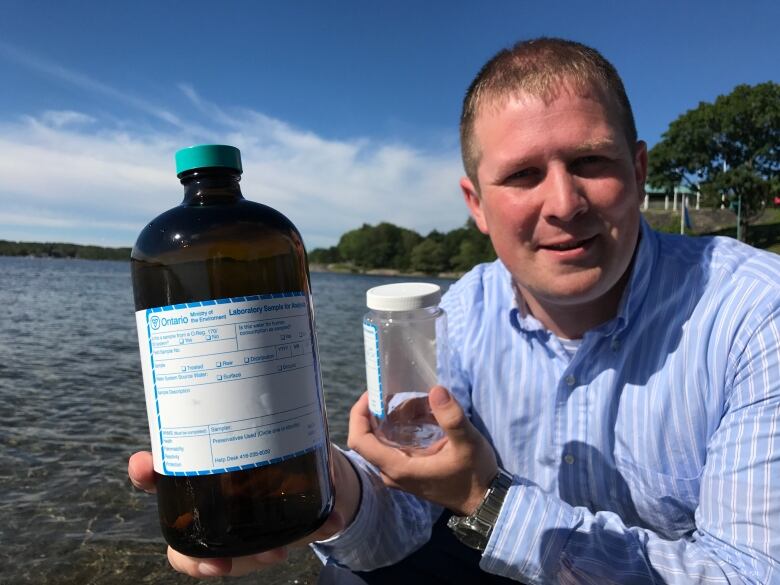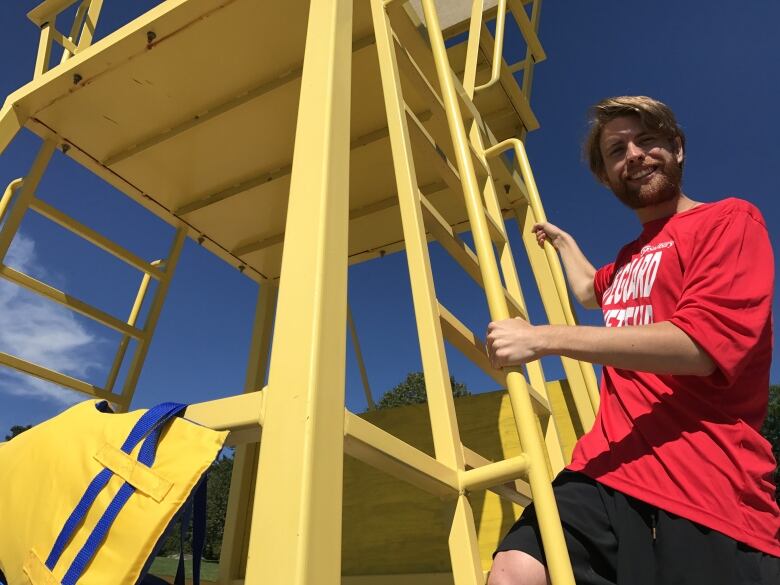Sudburians adapting to blue-green algae reports
'In a system like this, we should not be having blooms,' says Laurentian professor Charles Ramcharan

The sun shines down on Claire Smith who iskayaking on Ramsey Lake with her husband Dave and their sons Jake and Carter. The sun is also lighting up warning signs on manybeaches about blue-green algae blooms.
But Smith says she feels comfortable taking her family out on the water, as long as it's clear.
"We're not submerging ourselves in the water, and we're taking necessary precautions to make sure our kids aren't drinking water or getting saturated in it," she says.
The Sudbury & District Health Unit hasissued multiple reports ofblue-green algae blooms in lakes and on beaches, but officials say it's a pretty normal amount so far for the region.
- Blue-green algae confirmed on Ramsey Lake
- Blue green algae detected in St. Charles Lake: Sudbury health unit
- Elevated levels of bacteria found at Kalmo, Canoe Club beach
"Last year, we saw an increase in reports.The year before was dramatically less. But this year, we're on par with where we are most years," says Rylan Yade, an environmental support officer with the health unit.

Both the health unit and the City of Greater Sudbury test for blue-green algae blooms every week, but also rely on reports from lifeguards about the condition of the beaches.
Safe to swim if bloom says bye-bye
Cody Maletteis the waterfront program supervisor with the city and has been a lifeguard for seven years. He says people are generally receptive to getting out of the water when lifeguards spot the blooms, but are wondering when they can get back in.

"We try to let people know thatwhen the bloom is in our buoy lines, we strongly advise them to leave," says Malette.
"But once it's gone, then the water can be used for recreational activities, and it no longer poses that health risk for swimmers."
Blooms are 'man-made problem'
Charles Ramcharansays people shouldn't be fine with any number of blooms. The associate professor at Laurentian University's environmental science department says they're a man-made problem.
"We live on lakes that have very clear water, very low nutrients and there's absolutely no reason we should be having these types of blooms," says Ramcharan.

The exact cause of these blooms is unknown. Various factors like more sunlight, more rainfall and construction run-off could all have an effect. But Ramcharan says the city needs to have a phosphorus budget, especially with a major drinking water supply like Ramsey Lake.
"It's a standard approach to understanding the sources of phosphorous," says Ramcharan.
"Once you understand that, you can start to address the issue a little more intelligently. You can try and reduce the major sources and mitigate its effects."
Create a porous property
Ramcharan says run-off from homes is a concern. Storm drains bring whatever people put on their lawns into the lakes. He advises you make changes to your property like creatinga more permeable environment.
"If you're replacing your driveway and it's paved, replace it with something that's porous, like gravel. That helps a lot because that water percolates through the soil and by the time it gets to the lake, it's phosphorous free."

The health unit says it hasyet to receive any reports of people swimming or coming into contact with blue-green algae.
This shouldn't become normalizedsays Ramcharan. "It's entirely possible to have a dense urban pop on a system like this and still have a clear lake."
"It's not like it's some type of impossible goal, just because we're not doing it right now."












_(720p).jpg)


 OFFICIAL HD MUSIC VIDEO.jpg)
.jpg)



























































































